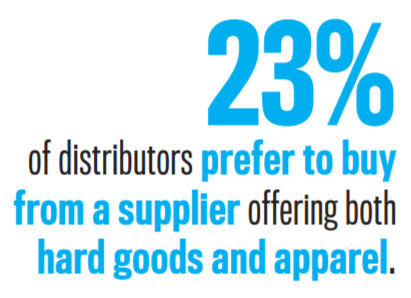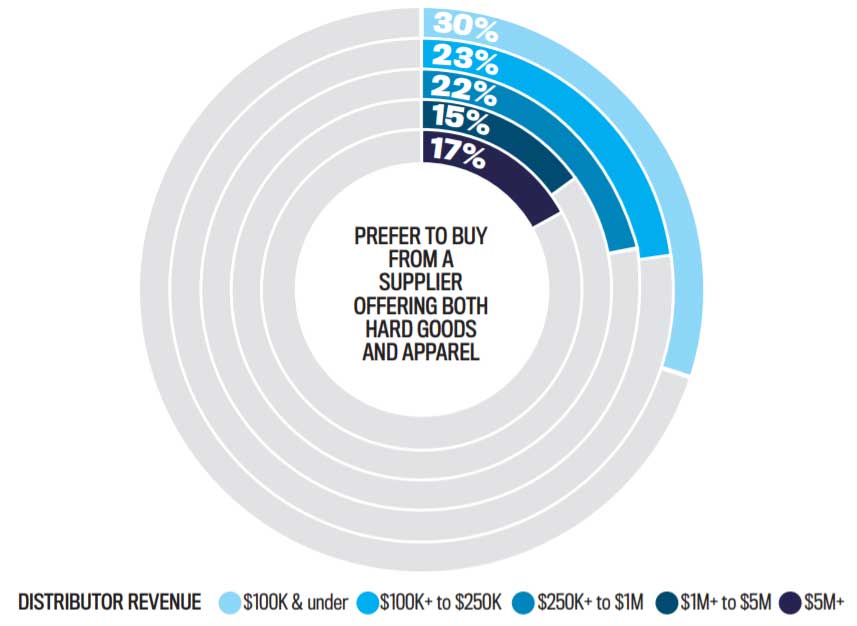July 10, 2019
SOI 2019: Consolidated Spend in the Promo Products Industry
One-stop shopping is in vogue in the promo sector as suppliers covet more market share.
Despite the plethora of suppliers offering school spirit products and apparel, Concepts Inc./Halftime Boosters (asi/217965) is only interested in working with Pepco Poms (asi/77280). After 65 years in business, the Georgia-based distributor sees value in a trusted relationship and a single source for items. “When it comes to purchasing from Pepco, they always work with me on rush orders, especially during playoff season,” says DeeDee Williams, internal operations manager at Concepts Inc.
More SOI 2019: Back to Main Page
Other distributors differ from following Concepts’ lead. According to SOI data, 23% of distributors say they prefer to purchase from suppliers that offer both hard goods and apparel. As more distributors look for streamlined order processes, diversified suppliers are becoming all the rage.
Traci Kontoulas, owner of Alabama-based Paradise Promotions & Designs (asi/129643), believes part of the sourcing preference – right or wrong – is generational. “Millennials want the easiest route – they search for someone who can do it all for them,” she says.

Convenience certainly plays a major role as well, Kontoulas adds, especially when bringing new management into the fold. Her sister joined the company two years ago, and Kontoulas says it’s been much easier just having her work with one supplier. “If there are fewer people involved in the transaction, there’s less confusion.”
But it’s not just confusion on the distributor side that factors into the equation. Matt Zinser, owner of New York-based KK Graphics Inc. (asi/243369), has been in the industry for less than a year. In that brief time, he’s had to endure misprints, delays and incorrect shipments from suppliers. While working with more vendors might offer unique options, Zinser places a priority on accuracy. “If you find a reliable source, you’re going to go to them for as much as you need,” he says.

Smaller distributors are most likely to order from a one-stop shop supplier.
Beyond providing correct orders, there are other considerations for distributors. “Some suppliers might be more of an expert, but do they have the other qualities we’re looking for – ample inventory, meeting deadlines, transparency and communication?” asks Bruce Munro, president of Able Recognition (asi/102304). “When you have a supplier that you know will do what they say, you tend to stick with them for all products.
A Bigger Bite
As distributors search for simple buying solutions, a few of the industry’s largest suppliers have begun offering added product categories.
Top 40 supplier HUB Promotional Group (asi/61966) has made eight acquisitions over the past two years, expanding its product line from just pens to technology accessories, lifestyle products, lanyards and more. “The one-stop shop trend is only going to excel among distributors, so we’re going to lean into it and present a well-rounded offering of hard goods,” says Chris Anderson, CEO of HUB.
“The one-stop shop trend will grow” — Chris Anderson, HUB
Pennsylvania-based Top 40 supplier alphabroder (asi/34063) made a big move into the hard-goods segment in 2017, acquiring long-time Top 40 supplier Prime Line (asi/79530). The deal increased alphabroder’s 2017 sales by more than $100 million. “Our customers have told us they want choice and convenience,” says Dan Pantano, president of alphabroder. “Having a full line of hard goods and apparel creates a true one-stop shop solution that drives efficiency and value for our customers.”
Top 40 supplier Hit Promotional Products (asi/61125) continues to push into wearables, which now represents 10% of the company’s overall revenue, says president CJ Schmidt. There were growing pains along the way – Schmidt estimates it took 24-30 months for his firm to get a grasp on the new category. “We had to recruit the proper talent that had more experience than our staff did,” he says. “We also had to adapt our systems and implement metrics for apparel.”
